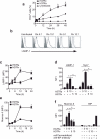Mycobacterium tuberculosis evades macrophage defenses by inhibiting plasma membrane repair
- PMID: 19561612
- PMCID: PMC2730354
- DOI: 10.1038/ni.1758
Mycobacterium tuberculosis evades macrophage defenses by inhibiting plasma membrane repair
Abstract
Induction of macrophage necrosis is a strategy used by virulent Mycobacterium tuberculosis (Mtb) to avoid innate host defense. In contrast, attenuated Mtb causes apoptosis, which limits bacterial replication and promotes T cell cross-priming by antigen-presenting cells. Here we show that Mtb infection causes plasma membrane microdisruptions. Resealing of these lesions, a process crucial for preventing necrosis and promoting apoptosis, required translocation of lysosomal and Golgi apparatus-derived vesicles to the plasma membrane. Plasma membrane repair depended on prostaglandin E(2) (PGE(2)), which regulates synaptotagmin 7 (Syt-7), the calcium sensor involved in the lysosome-mediated repair mechanism. By inducing production of lipoxin A(4) (LXA(4)), which blocks PGE(2) biosynthesis, virulent Mtb prevented membrane repair and induced necrosis. Thus, virulent Mtb impairs macrophage plasma membrane repair to evade host defenses.
Figures







Similar articles
-
Dying to live: how the death modality of the infected macrophage affects immunity to tuberculosis.Adv Exp Med Biol. 2013;783:103-20. doi: 10.1007/978-1-4614-6111-1_6. Adv Exp Med Biol. 2013. PMID: 23468106 Free PMC article. Review.
-
Lipid mediators in innate immunity against tuberculosis: opposing roles of PGE2 and LXA4 in the induction of macrophage death.J Exp Med. 2008 Nov 24;205(12):2791-801. doi: 10.1084/jem.20080767. Epub 2008 Oct 27. J Exp Med. 2008. PMID: 18955568 Free PMC article.
-
Lysosome-Mediated Plasma Membrane Repair Is Dependent on the Small GTPase Arl8b and Determines Cell Death Type in Mycobacterium tuberculosis Infection.J Immunol. 2018 May 1;200(9):3160-3169. doi: 10.4049/jimmunol.1700829. Epub 2018 Mar 28. J Immunol. 2018. PMID: 29592961 Free PMC article.
-
Apoptosis is an innate defense function of macrophages against Mycobacterium tuberculosis.Mucosal Immunol. 2011 May;4(3):279-87. doi: 10.1038/mi.2011.3. Epub 2011 Feb 9. Mucosal Immunol. 2011. PMID: 21307848 Free PMC article. Review.
-
Evasion of innate immunity by Mycobacterium tuberculosis: is death an exit strategy?Nat Rev Microbiol. 2010 Sep;8(9):668-74. doi: 10.1038/nrmicro2387. Epub 2010 Aug 2. Nat Rev Microbiol. 2010. PMID: 20676146 Free PMC article. Review.
Cited by
-
Differential MicroRNA Expression in Human Macrophages with Mycobacterium tuberculosis Infection of Beijing/W and Non-Beijing/W Strain Types.PLoS One. 2015 Jun 8;10(6):e0126018. doi: 10.1371/journal.pone.0126018. eCollection 2015. PLoS One. 2015. PMID: 26053546 Free PMC article.
-
Revisiting the role of the granuloma in tuberculosis.Nat Rev Immunol. 2012 Apr 20;12(5):352-66. doi: 10.1038/nri3211. Nat Rev Immunol. 2012. PMID: 22517424 Review.
-
More than a pore: the cellular response to cholesterol-dependent cytolysins.Toxins (Basel). 2013 Apr 12;5(4):618-36. doi: 10.3390/toxins5040618. Toxins (Basel). 2013. PMID: 23584137 Free PMC article. Review.
-
Plasma Eicosanoid Levels in Tuberculosis and Tuberculosis-Diabetes Co-morbidity Are Associated With Lung Pathology and Bacterial Burden.Front Cell Infect Microbiol. 2019 Oct 1;9:335. doi: 10.3389/fcimb.2019.00335. eCollection 2019. Front Cell Infect Microbiol. 2019. PMID: 31632923 Free PMC article.
-
Pathogenicity of Type I Interferons in Mycobacterium tuberculosis.Int J Mol Sci. 2023 Feb 15;24(4):3919. doi: 10.3390/ijms24043919. Int J Mol Sci. 2023. PMID: 36835324 Free PMC article. Review.
References
-
- McNeil PL, Steinhardt RA. Plasma membrane disruption: repair, prevention, adaptation. Annu. Rev. Cell Dev. Biol. 2003;19:697–731. - PubMed
-
- Roy D, et al. A process for controlling intracellular bacterial infections induced by membrane injury. Science. 2004;304:1515–1518. - PubMed
-
- Togo T, Alderton JM, Bi GQ, Steinhardt RA. The mechanism of facilitated cell membrane resealing. J. Cell Sci. 1999;112(Pt 5):719–731. - PubMed
Publication types
MeSH terms
Substances
Grants and funding
LinkOut - more resources
Full Text Sources
Molecular Biology Databases

